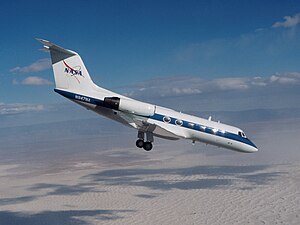Shuttle Training Aircraft
| C-11A Shuttle Training Aircraft | |
|---|---|
 |
|
| Role | Advanced trainer |
| Manufacturer | Grumman |
| Retired | 2012 |
| Status | Retired |
| Primary user | NASA |
| Number built | 4 |
| Developed from | Grumman Gulfstream II |
| Variants | Grumman C-11 |
The Shuttle Training Aircraft (STA) was a NASA training vehicle that duplicated the Space Shuttle's approach profile and handling qualities, allowing Space Shuttle pilots to simulate Shuttle landings under controlled conditions before attempting the task on board the orbiter.
The aircraft's exterior was modified to withstand the high aerodynamic forces incurred during training sorties. A redesigned cockpit provided a high-fidelity simulation of the Shuttle Orbiter's controls and pilot vantage point; even the seats were fitted in the same position as those in the Space Shuttle.
The four STAs were normally located at the NASA Forward Operating Location in El Paso, Texas and rotated through Ellington Field (Houston, Texas) for maintenance. The STA was also used at Kennedy Space Center in Florida. It was primarily flown by astronauts practicing landings at the Shuttle Landing Facility and White Sands Space Harbor as well as to assess weather conditions prior to Space Shuttle launches and landings.
On December 3, 2003, a NASA Gulfstream II shuttle Training Aircraft (STA) was flying a series of simulated shuttle landings to the Kennedy Space Center shuttle landing facility. On board the aircraft was an unidentified NASA astronaut pilot and two training personnel. The aircraft was on final approach at 13,000 feet when onboard instruments indicated a malfunction on one of the jet engine thrust reversers. The aircraft landed safely. A post-landing inspection showed that one of the 585-pound, 4-foot-wide, 5-foot-long thrust reversers had fallen off the aircraft. Divers later found the thrust reverser on the bottom of the nearby Banana River. An investigation showed that a bolt failed, releasing the part from the aircraft.
The STA was particularly critical for Shuttle pilots in training because the Orbiter lacked atmospheric engines that would allow the craft to "go around" after a poor approach. After re-entry, the Shuttle was a very heavy glider (it was sometimes referred to as a 'flying brick') and as such had only one chance to land.
...
Wikipedia
